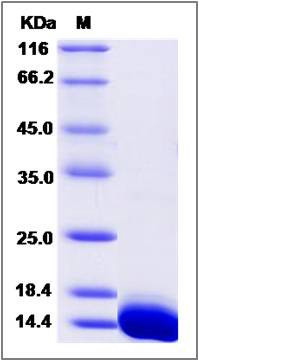Mouse S100A13 Protein (His Tag)
S100A13
- 100ug (NPP3463) Please inquiry
| Catalog Number | P50207-M07E |
|---|---|
| Organism Species | Mouse |
| Host | E. coli |
| Synonyms | S100A13 |
| Molecular Weight | The recombinant mouse S100A13 consists of 114 amino acids and predicts a molecular mass of 13.2 KDa. It migrates as an approximately 15 KDa band in SDS-PAGE under reducing conditions. |
| predicted N | Met |
| SDS-PAGE |  |
| Purity | > 90 % as determined by SDS-PAGE |
| Protein Construction | A DNA sequence encoding the mouse S100A13 (P97352) (Met1-Lys98) was expressed with a polyhistidine tag at the N-terminus. |
| Bio-activity | |
| Research Area | Immunology |Signal Transduction |Signaling Pathway |Calcium Signaling |Calcium Binding Protein |S100 Protein | |
| Formulation | Lyophilized from sterile PBS, 10% glycerol, pH 7.4. 1. Normally 5 % - 8 % trehalose and mannitol are added as protectants before lyophilization. Specific concentrations are included in the hardcopy of COA. |
| Background | S100 protein is a family of low molecular weight protein found in vertebrates characterized by two EF-hand calcium-binding motifs. There are at least 21 different S100 proteins, and the name is derived from the fact that the protein is 100% soluble in ammonium sulfate at neutral pH. Most S100 proteins are disulfide-linked homodimer, and is normally present in cells derived from the neural crest, chondrocytes, macrophages, dendritic cells, etc. S100 proteins have been implicated in a variety of intracellular and extracellular functions. They are involved in regulation of protein phosphorylation, transcription factors, the dynamics of cytoskeleton constituents, enzyme activities, cell growth and differentiation, and the inflammatory response. Protein S100-A13, also known as S100 calcium-binding protein A13, is a member of the S-100 family. It contains two EF-hand domains. S100A13 binds two calcium ions per subunit and one copper ion. Binding of one copper ion does not interfere with calcium binding. S100A13 is required for the copper-dependent stress-induced export of IL1A and FGF1. The calcium-free protein binds to lipid vesicles containing phosphatidylserine, but not to vesicles containing phosphatidylcholine. S100A13 plays a role in the export of proteins that lack a signal peptide and are secreted by an alternative pathway. |
| Reference |
